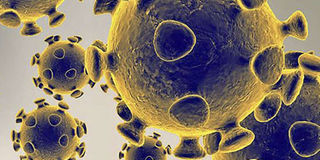Breaking News: At least 10 feared to have drowned in Makueni river
Seven out of 10 virus victims had hypertension, diabetes

An illustration image of the Covid-19 coronavirus, obtained on February 27, 2020, courtesy of the US Food and Drug Administration. PHOTO | AFP
What you need to know:
- Nairobi so far accounts for the highest number of confirmed infections and mortalities, followed by Mombasa, Kiambu and Kajiado counties.
Most of the reported deaths so far have been of people aged 60 years and above, with males accounting for more than 75 per cent of all.
Two out of every 100 Kenyans who have been infected with Covid-19 have died, data from the Ministry of Health shows. More than 220 deaths out of 12,000 confirmed infections have been reported so far, and a vast majority of them had serious underlying health conditions, with hypertension and diabetes presenting the biggest fatality risks.
Also, in what could illustrate the danger of co-infection the country faces as community transmission of Sars-CoV-2, the virus that causes Covid-19, escalates, nine out of every ten Kenyans who have the disease show no symptoms.
This means that, as more Kenyans let go of social distancing and other safety guidelines, they are exposing themselves and others to heightened infection risks.
217 DEATHS
However, it is the data on what is killing most patients that is most worrying. Of the 217 deaths reported by Thursday this week, 118 of them, or 54 per cent, had serious underlying diseases, 15 had no conditions and 84 had missing data on whether they had other ailments.
A combination of hypertension and diabetes appears to put patients at the highest risk. Of those who have died so far, 38 had both diseases, 25 had hypertension, and 16 had diabetes.
Therefore, of all the reported mortalities so far, about seven out of every 10 (67 per cent) had hypertension or diabetes, or both.
Even before Covid-19, hypertension was a leading cause of death worldwide, causing as many as 7.5 million deaths annually, according to the World Health Organization.
A 2018 study found that about three out of every 10 Kenyans had elevated blood pressure, yet, of those living with the condition, only two out of every 10 were aware they had it.
DIABETES
Diabetes, on the other hand, affects three out of every 100 Kenyans, but that prevalence is expected to rise to five by the year 2025, according to various surveys by the Ministry of Health.
Both diseases are prevalent in urban centres, and with Covid-19 showing striking infection patterns in Kenya’s urban and peri-urban zones, doctors fear that the mortality rate could be significantly higher among those populations compared to others across the country.
Nairobi so far accounts for the highest number of confirmed infections and mortalities, followed by Mombasa, Kiambu and Kajiado counties. About nine out of every 10 deaths reported so far have occurred in these high-risk counties, while Kitui, Laikipia, Lamu, Migori, Nyeri and Siaya have reported the least fatalities so far, at only one patient each.
The total tests carried out so far are about 230,000 with confirmed cases at slightly over 12,000. When pitted against Kenya’s population of about 47 million, the positivity rate stands at about five per cent.
ATTACK RATE
So far, data indicates that the coronavirus’ attack rate could be as high as 25 out of every 100,000 Kenyans. An attack rate is a hypothetical prediction used by epidemiologists to indicate the percentage of a population that could contract a disease within a specific time. Scientists use it to project the number of victims and to marshall resources.
However, Kenya’s high number of assymptomatics could mean that, even where the attack rate is high — such as in Nairobi, where about 150 people out of every 100,000 could contract the virus — the rate of hospitalisation and mortality could remain low as most will fight it off without requiring medical interventions.
Most of the reported deaths so far have been of people aged 60 years and above, with males accounting for more than 75 per cent of all.
That could be explained by the fact that majority of Kenya’s cases are in the relatively healthy age of between 20 and 39. They have shown no symptoms, and most of them have been discharged with minimal, if any, clinical interventions.
Of the 10 per cent that show symptoms, more than half of them, at 55 per cent, complain of coughing, followed by fever at 43 per cent, difficulty in breathing (28 per cent) and headache (16 per cent).




